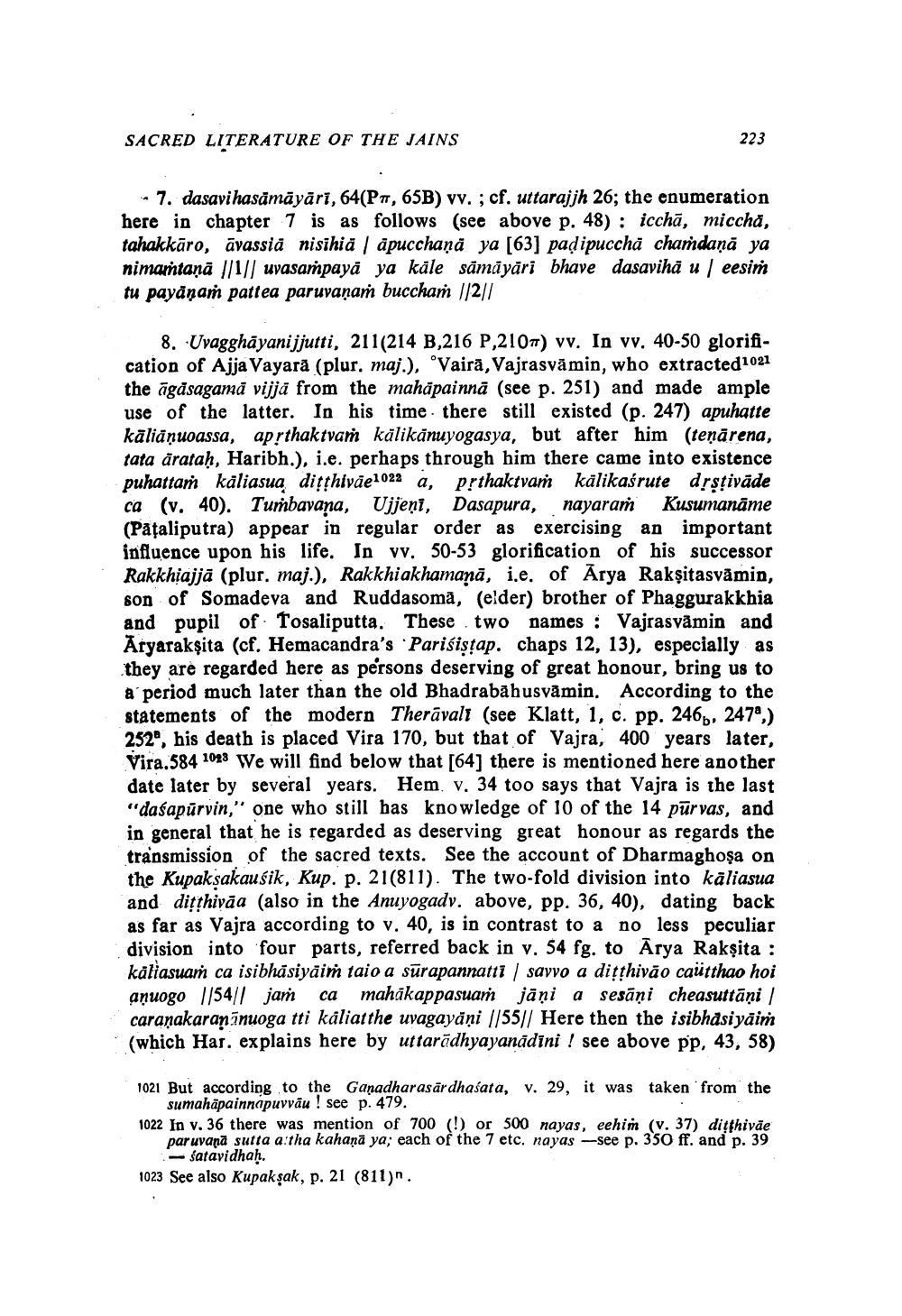________________
SACRED LITERATURE OF THE JAINS
223
- 7. dasavihasāmāyāri, 64(P7,65B) vv. ; cf. uttarajjh 26; the enumeration here in chapter 7 is as follows (see above p. 48): icchā, miccha, tahakkāro, āvassia nisihia | apucchaņā ya [63] padipuccha chaṁdaņā ya nimantana 1/1/) uvasaṁpaya ya kale sāmāyari bhave dasaviha u | eesi tu payäņam pattea paruvaņaṁ bucchaṁ //2/1
8. Uvagghāyanijjutti, 211(214 B,216 P,2107) vv. In vv. 40-50 glorification of Ajja Vayară (plur, maj.), °Vairā, Vajrasvāmin, who extracted1021 the āgasagamă vijja from the mahāpainnā (see p. 251) and made ample use of the latter. In his time there still existed (p. 247) apuhatte kāliāņuoassa, aprthaktvaṁ kālikānuyogasya, but after him (teņārena, tata äratah, Haribh.), i.e. perhaps through him there came into existence puhattaṁ kaliasua ditļhivāe1022 a, prthaktvaṁ kälikaśrute drsțivāde ca (v. 40). Tumbavana, Ujjeņi, Dasapura, nayaraṁ Kusumanāme (Pataliputra) appear in regular order as exercising an important influence upon his life. In vv. 50-53 glorification of his successor Rakkhiajjā (plur, maj.), Rakkhiakhamaņā, i.e. of Arya Raksitasvämin, son of Somadeva and Ruddasomā, (elder) brother of Phaggurakkhia and pupil of Tosaliputta. These two names : Vajrasvåmin and Aryarakşita (cf. Hemacandra's Parisistap. chaps 12, 13), especially as they are regarded here as persons deserving of great honour, bring us to a period much later than the old Bhadrabāhusvāmin. According to the statements of the modern Therāvalt (see Klatt, 1, c. pp. 246, 2470) 252°, his death is placed Vira 170, but that of Vajra, 400 years later, Vira.584 1023 We will find below that [64] there is mentioned here another date later by several years. Hem v. 34 too says that Vajra is the last "dasapūrvin," one who still has knowledge of 10 of the 14 pūrvas, and in general that he is regarded as deserving great honour as regards the transmission of the sacred texts. See the account of Dharmaghosa on the Kupaksakausik, Kup. p. 21(811). The two-fold division into kāliasua and dițțhivaa (also in the Anuyogadv. above, pp. 36, 40), dating back as far as Vajra according to v. 40, is in contrast to a no less peculiar division into four parts, referred back in v. 54 fg. to Arya Rakşita : käliasuaṁ ca isibhāsiyaiṁ taio a sūrapannatti / savvo a ditthivão caütthao hoi aņuogo 1/54|| jam ca mahākappasuam jāņi a sesāņi cheasuttāņi / caranakaranīnuoga tti kaliatthe uvagayāņi //55// Here then the isibhasi yāiń (which Har. explains here by uttarādhyayanādini ! see above pp, 43, 58)
1021 But according to the Ganadharasārdhasata, V. 29, it was taken from the
sumahāpainnapuvvāu ! see p. 479. 1022 In v. 36 there was mention of 700 (!) or 500 nayas, eehim (v. 37) ditthivāe
par uvanā sutta a:tha kahaņā ya; each of the 7 etc. nayas-see p. 350 ff. and p. 39
:-satavidhah. 1023 See also Kupakşak, p. 21 (811)n.




